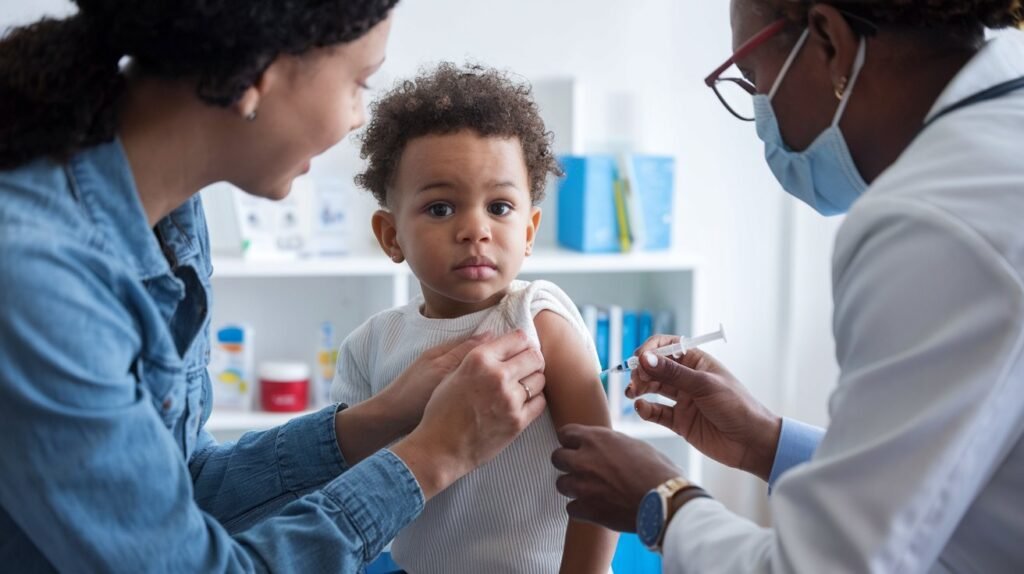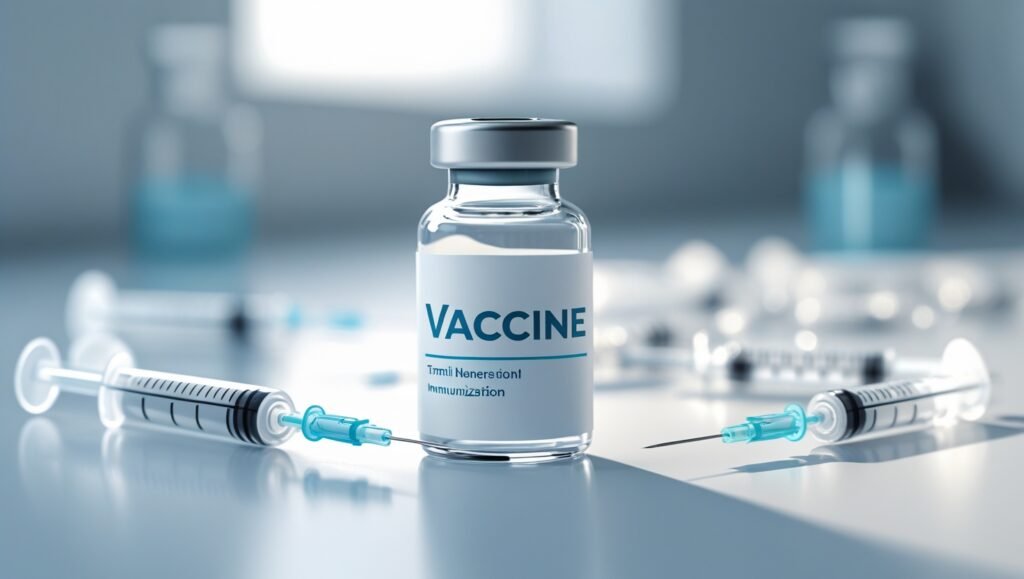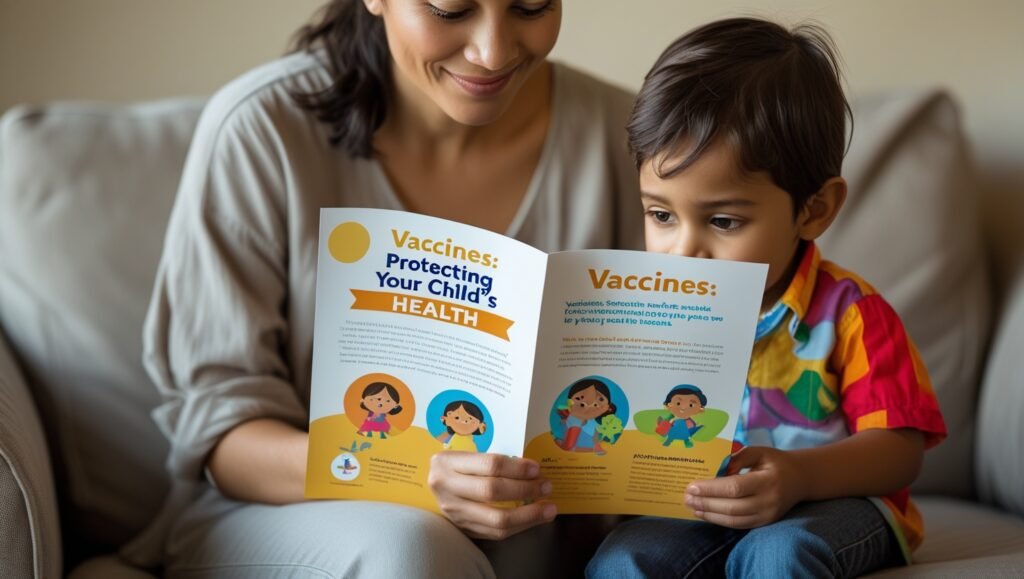Introduction: Why childhood vaccines Matter?
Childhood vaccines are one of the most significant advancements in modern medicine, yet they remain a topic of curiosity and concern for many parents. Have you ever wondered how a simple shot can protect your child from life-threatening diseases? Or why healthcare professionals emphasize sticking to the recommended vaccine schedule? In a world where misinformation spreads as quickly as the viruses we aim to prevent, understanding the science, safety, and importance of childhood vaccines is more critical than ever.
This blog will guide you through everything you need to know about childhood vaccines—from how vaccines work to their role in safeguarding not just your child, but the entire community. Whether you’re a new parent navigating the immunization schedule or someone seeking clarity on common misconceptions, we’ve got you covered. Let’s dive into the world of childhood vaccines and explore how they shape healthier futures for our children and generations to come.
Table of Contents
Childhood Vaccines
The Importance of Childhood Vaccines
When it comes to protecting your child’s health, few tools are as powerful as childhood vaccines. But why are they so crucial? Let’s break it down in a way that’s easy to understand and hard to forget.

Protecting Children from Serious Diseases
Childhood vaccines are designed to shield kids from diseases that were once widespread and often deadly. Think about measles, polio, or whooping cough—illnesses that used to claim countless young lives. Thanks to vaccines, many of these diseases are now rare, but they haven’t disappeared entirely. Vaccines act as a protective barrier, ensuring your child doesn’t fall victim to these preventable conditions.
Building Herd Immunity for Community Safety
Did you know that vaccinating your child doesn’t just protect them—it helps protect others too? This concept is called herd immunity. When a large portion of the community is vaccinated, it becomes harder for diseases to spread. This is especially important for those who can’t receive vaccines, like newborns or individuals with certain medical conditions. By vaccinating your child, you’re contributing to a safer environment for everyone.
Preventing Long-Term Health Complications
Some childhood diseases don’t just cause short-term illness—they can lead to lifelong complications. For example, measles can result in brain damage, and polio can cause permanent paralysis. Vaccines help prevent these devastating outcomes, ensuring your child grows up healthy and strong.
Reducing Healthcare Costs for Families
Let’s face it: medical bills can be overwhelming. Treating vaccine-preventable diseases often requires hospitalization, medications, and ongoing care, which can strain family finances. Vaccines, on the other hand, are a cost-effective way to avoid these expenses. Investing in vaccines now can save you from significant financial stress down the road.
A Quick Recap: Why Vaccines Matter
- Protect your child from dangerous diseases.
- Support herd immunity to safeguard the community.
- Prevent long-term health issues that can affect quality of life.
- Save money by avoiding costly medical treatments.
Childhood vaccines are more than just a medical recommendation—they’re a cornerstone of public health. By understanding their importance, you’re taking a proactive step toward ensuring your child’s well-being and the health of those around them. Ready to learn more about how vaccines work? Let’s keep going!
How Vaccines Work
Ever wondered how a tiny shot can protect your child from serious illnesses? It’s like giving their immune system a training session—preparing it to fight off real threats without the risk of severe illness. Let’s dive into the fascinating science behind vaccines and how they keep your little ones safe.
The Science Behind Immunization
Vaccines work by mimicking an infection, but without causing the disease itself. They introduce a weakened or inactive part of a germ (like a virus or bacteria) into the body. This might sound scary, but it’s completely safe. The immune system recognizes these invaders as foreign and gets to work building defenses.
Think of it like a fire drill: your child’s immune system practices responding to a threat so it’s ready to act quickly and effectively if the real thing ever shows up.
The Role of Antibodies in Fighting Infections
When a vaccine is administered, the immune system produces special proteins called antibodies. These antibodies are like tiny soldiers trained to recognize and attack specific germs. Once the immune system creates these antibodies, it remembers the germ. If your child is ever exposed to the real disease in the future, their body can quickly produce the same antibodies to fight it off.
This process is why vaccines provide long-lasting protection. It’s like giving your child’s immune system a cheat sheet for defeating harmful germs.
Understanding Vaccine Ingredients and Safety
It’s natural to wonder what’s inside a vaccine and whether it’s safe for your child. Here’s the breakdown:
- Antigens: The active ingredient that triggers the immune response.
- Adjuvants: Boosters that help the immune system respond more strongly.
- Stabilizers: Keep the vaccine effective during storage and transport.
- Preservatives: Ensure the vaccine remains free from contamination.
Every ingredient in a vaccine is carefully tested and monitored for safety. Regulatory agencies like the FDA and WHO rigorously evaluate vaccines before they’re approved for use. Rest assured, vaccines are one of the most studied and safest medical interventions available.
A Quick Look at the Process
- Introduction: The vaccine introduces a harmless version of the germ.
- Recognition: The immune system identifies the germ as a threat.
- Response: Antibodies are produced to fight the germ.
- Memory: The immune system remembers the germ for future protection.
Why This Matters
Understanding how vaccines work can help ease any concerns you might have. They’re not just a medical tool—they’re a way to empower your child’s body to defend itself against dangerous diseases. By vaccinating your child, you’re giving their immune system the tools it needs to stay healthy.
Ready to explore the specific childhood vaccines your child needs? Let’s move on to the next section!
Common Childhood Vaccines and Their Benefits
When it comes to childhood vaccines, it’s not just about getting shots—it’s about giving your child a shield against some of the most dangerous diseases out there. But which vaccines are essential, and what exactly do they protect against? Let’s explore the most common childhood vaccines and the life-saving benefits they offer.
Measles, Mumps, and Rubella (MMR) Vaccine
The MMR vaccine is a triple-threat protector, guarding against three highly contagious diseases:
- Measles: Can cause high fever, rash, and even brain damage.
- Mumps: Known for painful swelling of the salivary glands and potential hearing loss.
- Rubella: Especially dangerous for pregnant women, as it can lead to severe birth defects.
By vaccinating your child with the MMR vaccine, you’re not only protecting them but also helping to prevent outbreaks in your community.
Polio Vaccine: Eradicating a Global Threat
Polio was once a leading cause of paralysis in children worldwide. Thanks to the polio vaccine, this disease is now on the brink of eradication. The vaccine works by priming the immune system to fight off the poliovirus, ensuring your child can grow up without the fear of this debilitating illness.
The Importance of the DTaP Vaccine
The DTaP vaccine is another powerhouse, protecting against three serious diseases:
- Diphtheria: A throat infection that can block airways and damage the heart.
- Tetanus: Often called “lockjaw,” it causes painful muscle stiffness and can be fatal.
- Pertussis (Whooping Cough): A highly contagious respiratory infection that can be life-threatening for infants.
This vaccine is typically given in a series of doses to ensure long-lasting protection.
Flu Vaccines for Children: Why They Matter
You might think of the flu as just a bad cold, but for young children, it can be much more severe. The flu vaccine is updated every year to match the most common strains of the virus. By vaccinating your child, you’re reducing their risk of complications like pneumonia, hospitalization, and even death.
A Quick Guide to Vaccine Benefits
Here’s a snapshot of what these childhood vaccines offer:
- MMR Vaccine: Protects against measles, mumps, and rubella.
- Polio Vaccine: Prevents paralysis and supports global eradication efforts.
- DTaP Vaccine: Shields against diphtheria, tetanus, and whooping cough.
- Flu Vaccine: Reduces the severity and spread of seasonal influenza.
Why These Vaccines Are Essential
Each of these vaccines plays a critical role in keeping your child healthy. They’re not just about individual protection—they’re about creating a safer world for everyone. By staying up-to-date on your child’s vaccinations, you’re taking a proactive step toward their well-being and the health of future generations.
Curious about how to address common concerns or misconceptions about childhood vaccines? Let’s tackle that next!
Addressing Vaccine Concerns and Misconceptions
It’s natural to have questions or concerns about childhood vaccines. After all, you want what’s best for your child, and sorting through conflicting information can feel overwhelming. Let’s address some of the most common vaccine concerns and misconceptions, so you can feel confident in your decisions.

Debunking Myths About Vaccine Safety
One of the biggest myths is that vaccines aren’t safe. The truth? Vaccines undergo rigorous testing and monitoring before they’re approved for use. Organizations like the FDA and CDC continuously track vaccine safety to ensure they meet the highest standards.
For example, the myth linking the MMR vaccine to autism has been thoroughly debunked by numerous studies. The original study that sparked this concern was found to be fraudulent, and its author lost his medical license. Vaccines are safe, and they save lives.
Understanding the Role of Side Effects
Some parents worry about side effects, but it’s important to put them into perspective. Most side effects are mild and temporary, such as:
- A sore arm at the injection site
- Low-grade fever
- Mild fussiness or fatigue
These reactions are a sign that the immune system is doing its job. Serious side effects are extremely rare—far rarer than the complications caused by the diseases vaccines prevent.
The Importance of Trusting Scientific Evidence
In the age of social media, misinformation spreads quickly. It’s easy to stumble upon alarming stories or anecdotes, but these often lack scientific backing. Trusting peer-reviewed research and expert consensus is key.
For instance, studies show that vaccinated children are not only healthier but also contribute to lower disease rates in their communities. Science consistently supports the safety and effectiveness of vaccines.
Common Concerns Addressed
Let’s tackle a few more questions you might have:
- “Are vaccines tested on children?” Yes, vaccines are rigorously tested in clinical trials involving thousands of participants, including children, to ensure safety and effectiveness.
- “Can vaccines overload my child’s immune system?” No, a child’s immune system is capable of handling the antigens in vaccines. In fact, they’re exposed to far more germs in everyday life.
- “Do vaccines contain harmful ingredients?” Vaccine ingredients are carefully selected and tested. For example, thimerosal, a preservative once used in some vaccines, has been removed or reduced to trace amounts in childhood vaccines since 2001.
A Quick Checklist for Parents
- Rely on credible sources: Consult your pediatrician or trusted health organizations like the CDC or WHO.
- Understand the risks: Weigh the minimal risks of vaccines against the serious risks of the diseases they prevent.
- Ask questions: Don’t hesitate to discuss your concerns with a healthcare professional.
Why Addressing Concerns Matters
By understanding the facts, you can make informed decisions that protect your child’s health. Vaccines are one of the most effective tools we have to prevent disease, and addressing concerns head-on helps ensure more children can benefit from their life-saving power.
Ready to learn about the recommended vaccine schedule? Let’s move forward!
The Vaccine Schedule: What Parents Need to Know
Navigating the childhood vaccine schedule can feel like decoding a complex map, but it doesn’t have to be overwhelming. Understanding the why and when behind each vaccine can help you stay on track and ensure your child gets the protection they need at the right time. Let’s break it down together.

Overview of the Recommended Vaccine Timeline
The vaccine schedule is carefully designed by experts to provide immunity when children are most vulnerable. It starts at birth and continues into adolescence, with vaccines given at specific ages to maximize their effectiveness. Here’s a quick snapshot:
- At Birth: Hepatitis B (first dose)
- 2 Months: DTaP, Hib, PCV, IPV, Rotavirus
- 6 Months: Flu vaccine (annual)
- 12-18 Months: MMR, Varicella (chickenpox), Hepatitis A
- 4-6 Years: DTaP, IPV, MMR (second dose)
- 11-12 Years: HPV, Tdap, Meningococcal
This timeline ensures your child is protected during critical stages of their development.
Why Timing Matters for Maximum Protection
Childhood vaccines are timed to protect children when they’re most at risk. For example, babies are particularly vulnerable to diseases like whooping cough, which is why the DTaP vaccine starts at 2 months. Delaying vaccines can leave your child unprotected during these high-risk periods.
Think of it like building a fence around your home: you wouldn’t wait until a storm hits to start construction. Vaccines work the same way—they prepare your child’s immune system before they’re exposed to potential threats.
Catching Up on Missed Vaccines
Life gets busy, and sometimes vaccines are delayed. The good news? It’s never too late to catch up. Pediatricians can create a customized plan to get your child back on track. Whether it’s a missed dose of the MMR vaccine or a delayed HPV shot, catching up ensures your child stays protected.
A Parent’s Guide to Staying Organized
Keeping track of vaccines can feel like a juggling act, but these tips can help:
- Use a vaccine tracker: Many apps and tools are available to help you stay on top of the schedule.
- Ask for records: Your pediatrician can provide a detailed vaccine record for your child.
- Set reminders: Mark upcoming vaccine appointments on your calendar or phone.
Why Following the Schedule Matters
Sticking to the recommended vaccine schedule isn’t just about convenience—it’s about providing the best protection for your child. Childhood vaccines are most effective when given at the right time, and staying on track helps ensure your child is shielded from preventable diseases.
By understanding the vaccine schedule, you’re taking an active role in safeguarding your child’s health. For the latest vaccine recommendations, visit the CDC’s vaccine schedule page.
Conclusion: Final Thoughts About Childhood Vaccines
As we wrap up this deep dive into childhood vaccines, let’s take a moment to reflect on what we’ve learned. Vaccines are more than just a medical recommendation—they’re a powerful tool to protect your child’s health, your family’s well-being, and the broader community. From understanding how vaccines work to debunking common myths, we’ve covered the essentials to help you make informed decisions.
Think about it: when you vaccinate your child, you’re not just shielding them from diseases like measles, polio, or whooping cough—you’re also contributing to herd immunity, which keeps vulnerable populations safe. You’re giving them the gift of a healthier future, free from the fear of preventable illnesses.
But let’s not forget the bigger picture. Vaccines have transformed public health, eradicating diseases that once caused widespread suffering. By staying up-to-date on your child’s vaccine schedule, you’re playing a part in this incredible legacy.
If you’ve ever felt unsure or overwhelmed, remember that you’re not alone. Pediatricians, healthcare providers, and trusted organizations like the CDC and WHO are here to guide you every step of the way. Don’t hesitate to ask questions, seek clarity, and stay informed.
So, what’s the next step? Take a look at your child’s vaccine records, schedule any missed doses, and keep the conversation going. Together, we can ensure that every child grows up healthy, protected, and ready to thrive.
Thank you for taking the time to learn about childhood vaccines. By prioritizing your child’s health, you’re not just making a difference for them—you’re helping to create a safer, healthier world for us all. Here’s to a future where preventable diseases are a thing of the past!
References
- Centers for Disease Control and Prevention (CDC): Childhood Vaccination Schedule.
- World Health Organization (WHO): Immunization Overview
- American Academy of Pediatrics (AAP): Vaccine Information for Parents.
- Mayo Clinic: Vaccine Benefits and Safety.
- National Institute of Allergy and Infectious Diseases (NIAID): How Vaccines Work.
- Immunize.org: Vaccine FAQs and Resources.
- History of Vaccines (by The College of Physicians of Philadelphia): Historical Impact of childhood vaccines.
- PubMed Central (PMC): Peer-Reviewed Studies on Vaccine Safety and Efficacy.




